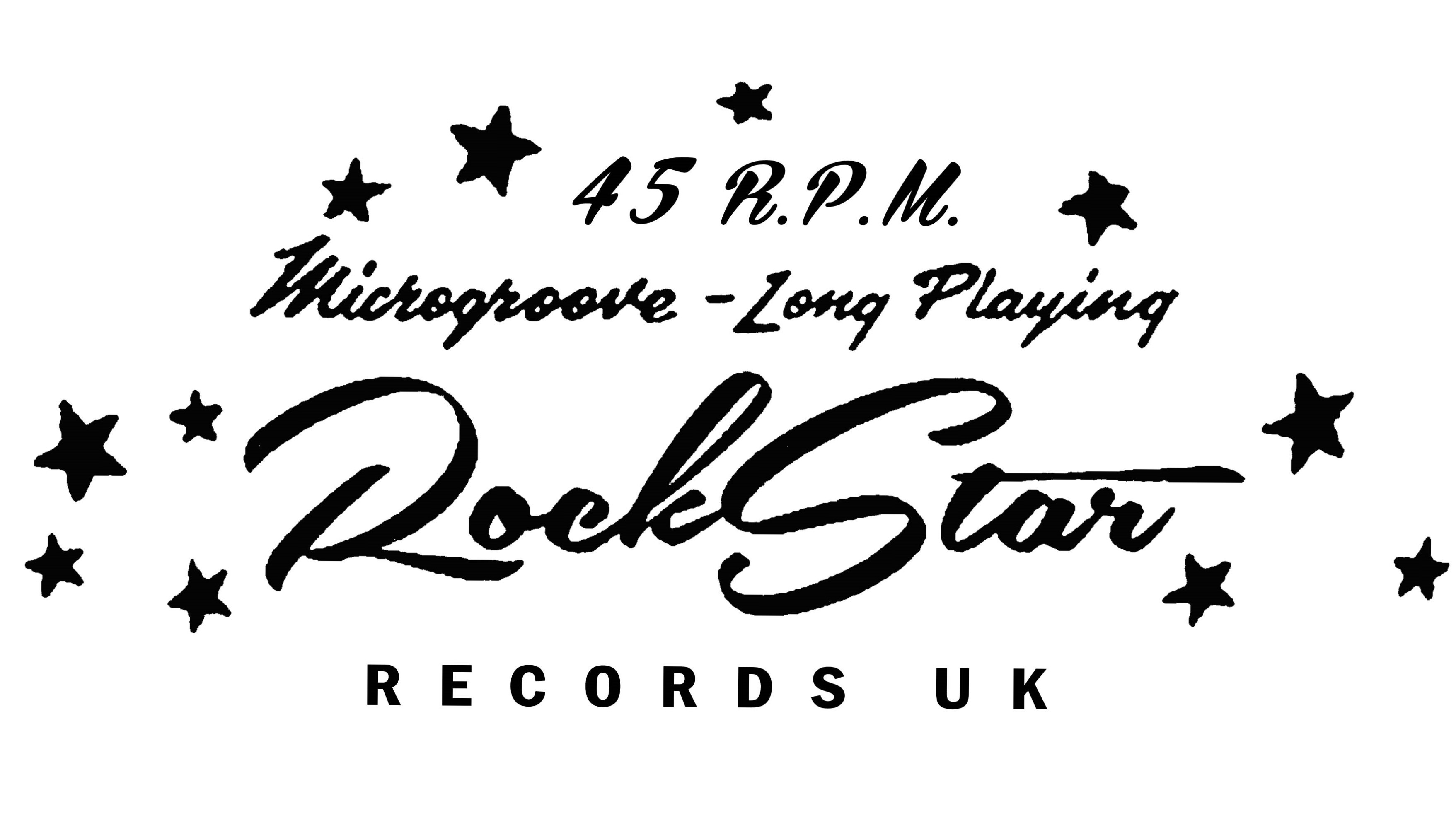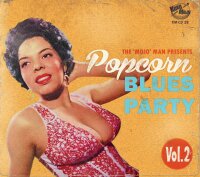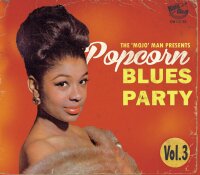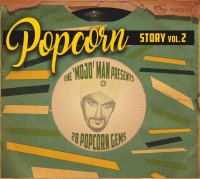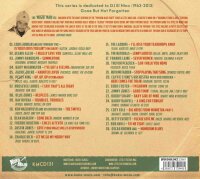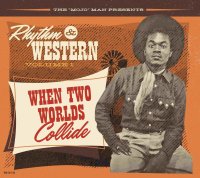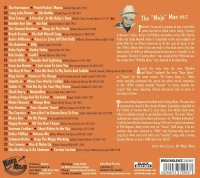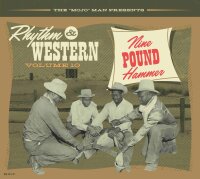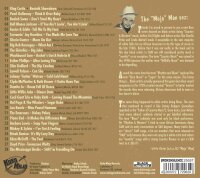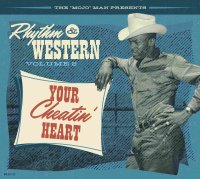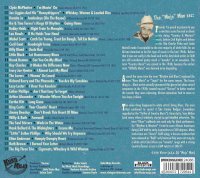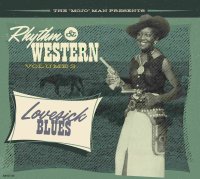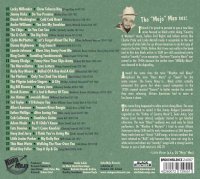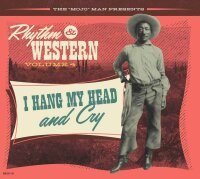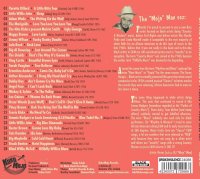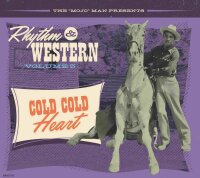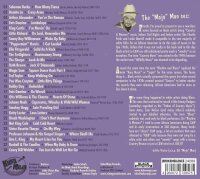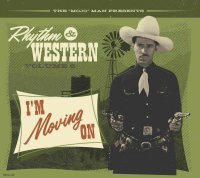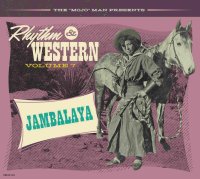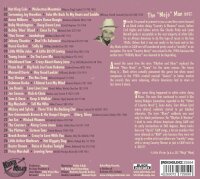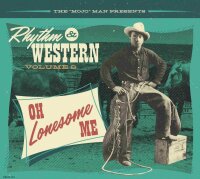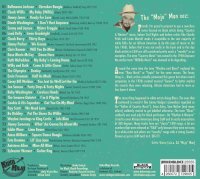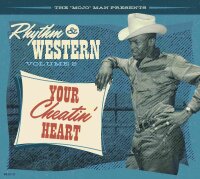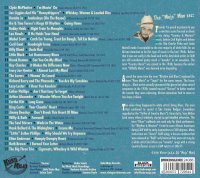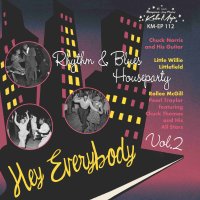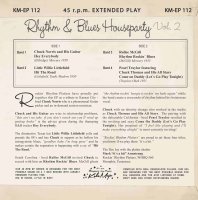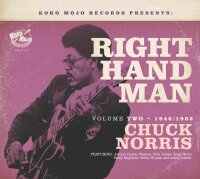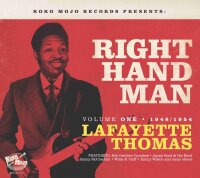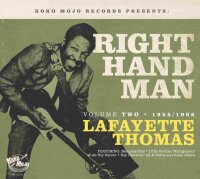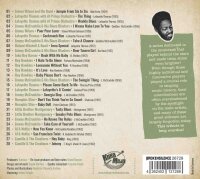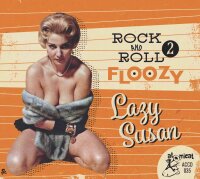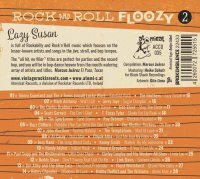Black Shack Calw
Black Shack Calw
Artikel 121 - 140 von 190
22 Popcorn Blues classics from the early 1960s. Remastered. Volume 2 (of 3)
Finale volume of Popcorn Blues Party, 22 Killers
Popcorn Story 1
Popcorn Story 2
THE "MOJO" MAN SEZ: Friends I'm proud to present to you a new Boss series focused on black artists doing "Country & Western" music, before Civil Rights and before artists like Charlie Pride and Linda Martell made it acceptable to the vast majority of white folks for an African American to do this type of music in the late 1960s. Before that it was not really in the book and to this day black artists in C&W are still considered pretty much a "novelty" or an exception. The term "Country Music" was coined in the 1940s because the earlier term "Hillbilly Music" was deemed to be degrading. Around the same time the term "Rhythm and Blues" replaced the term "Race Music" or "Sepia" for the same reason. The funny thing is... Black artists actually pioneered this genre but when record companies in the 1920s created musical "Genres" to better market the records they were releasing, African Americans had to more or less leave it alone. The same thing happened to white artists doing Blues. The ones that continued to record it like Jimmy Rodgers (nowadays regarded as the "Father of Country Music"), Gene Autry, Sam McGee (and many others) suddenly started to get labelled otherwise. The term "Blues" suddenly was used only for black performers. On "Rhythm & Western" I tried to cover African Americans doing C&W and its early incarnations at 360 degrees. Many tracks here are "classic" C&W songs, a lot are numbers that were released as "R&B" only because they were not sung by a white artist and others are "novelty" songs with a strong Country flavour or just a C&W twist to it. DIG IT!
Rhythm & Western Vol.10 - Nine Pond Hammer
THE "MOJO" MAN SEZ: Friends I'm proud to present to you a new Boss series focused on black artists doing "Country & Western" music, before Civil Rights and before artists like Charlie Pride and Linda Martell made it acceptable to the vast majority of white folks for an African American to do this type of music in the late 1960s. Before that it was not really in the book and to this day black artists in C&W are still considered pretty much a "novelty" or an exception. The term "Country Music" was coined in the 1940s because the earlier term "Hillbilly Music" was deemed to be degrading. Around the same time the term "Rhythm and Blues" replaced the term "Race Music" or "Sepia" for the same reason. The funny thing is... Black artists actually pioneered this genre but when record companies in the 1920s created musical "Genres" to better market the records they were releasing, African Americans had to more or less leave it alone. The same thing happened to white artists doing Blues. The ones that continued to record it like Jimmy Rodgers (nowadays regarded as the "Father of Country Music"), Gene Autry, Sam McGee (and many others) suddenly started to get labelled otherwise. The term "Blues" suddenly was used only for black performers. On "Rhythm & Western" I tried to cover African Americans doing C&W and its early incarnations at 360 degrees. Many tracks here are "classic" C&W songs, a lot are numbers that were released as "R&B" only because they were not sung by a white artist and others are "novelty" songs with a strong Country flavour or just a C&W twist to it. DIG IT!
-Little Victor (a.k.a. DJ "Mojo" Man)
THE "MOJO" MAN SEZ: Friends I'm proud to present to you a new Boss series focused on black artists doing "Country & Western" music, before Civil Rights and before artists like Charlie Pride and Linda Martell made it acceptable to the vast majority of white folks for an African American to do this type of music in the late 1960s. Before that it was not really in the book and to this day black artists in C&W are still considered pretty much a "novelty" or an exception. The term "Country Music" was coined in the 1940s because the earlier term "Hillbilly Music" was deemed to be degrading. Around the same time the term "Rhythm and Blues" replaced the term "Race Music" or "Sepia" for the same reason. The funny thing is... Black artists actually pioneered this genre but when record companies in the 1920s created musical "Genres" to better market the records they were releasing, African Americans had to more or less leave it alone. The same thing happened to white artists doing Blues. The ones that continued to record it like Jimmy Rodgers (nowadays regarded as the "Father of Country Music"), Gene Autry, Sam McGee (and many others) suddenly started to get labelled otherwise. The term "Blues" suddenly was used only for black performers. On "Rhythm & Western" I tried to cover African Americans doing C&W and its early incarnations at 360 degrees. Many tracks here are "classic" C&W songs, a lot are numbers that were released as "R&B" only because they were not sung by a white artist and others are "novelty" songs with a strong Country flavour or just a C&W twist to it. DIG IT!
-Little Victor (a.k.a. DJ "Mojo" Man)
Rhythm & Western Vol.4 - I Hang My Head And Cry
Rhythm & Western Vol.5 - Cold Cold Heart
Rhythm & Western Vol.6 - I´m Moving On
The great Mickey & Sylvia open the ball with "I'm So Glad" and right after that Big Al Downing delivers a great version of the C&W classic "When My Blue Moon Turns To Gold Again" a song recorded by Merle Haggard, Elvis, Hank Thompson, Bill Monroe, Jim Reeves and many more. King Curtis follows with a fantastic version of "Steel Guitar Rag" (I already gave extended info about this song in a previous volume). Little Willie John delivers a heartfelt version of "She Thinks I Still Care" a number that was recorded by George Jones and many other Country artists. "Haunted House" has been regarded as a classic C&W song since the early 1960s when Gene Simmons had a big hit with it and many other C&W singers covered it. I included the original 1950s version by Johnny Fuller which sounds just as "country" as the white counterparts and even features a banjo!
Rhythm & Western Vol.7 - Jambalaya
We're kicking off with Nat King Cole doing "Wolverton Mountain", a country music song and a big crossover hit that established Claude King's career as an American country singer-songwriter in 1962, then another version of the Gene Autry C&W classic "Take Me Back To My Boots And Saddle" by Screamin' Jay Hawkins this time. Amos Milburn turns square dance into boogie-woogie, followed by Baby Washington and Bobby Bland with two "melanated" western tunes. Titus Turner gives a new spin to Hank William's classic "Jambalaya" and R&B vocalist Johnny Thunder is next with "Don't Be Ashamed" a song that has a strong C&W and Gospel flavor. Memphian Rosco Gordon gives a perfect example of “Ebony Country Music" with the self-penned "Sally Jo" originally released on Sun Records. Same for Little Willie John and the Young Jessie tunes. Washboard Sam is next with a proto-Western Swing number titled "Crazy About Nancy Jane" and Piano Red's "Big Rock Joe From Kokomo" brings to mind Moon Mullican and all the other Hillbilly piano players he often also inspired.
Rhythm & Western Vol.8 - Oh Lonesome Me
Rhythm & Western Vol.9 - You Are My Sunshine
Formative R&B rockers from Chuck Norris, Little Willie Littlefield, Rollee McGill, and Pearl Traylor
Chuck Norris Vol.1 1946-1955
Norris originates from the Midwest, born in Kansas City, Missouri on August 11, 1921, and raised in Chicago, where he studied under the fabled music instructor Captain Walter Dyett at Chicago's DuSable High School.
Here, he learned to read music, and his versatility and keeping up with the trends kept him in constant demand, resulting in a career that spanned four decades.
In the mid-40s, Norris relocated to Los Angeles where his performances in local clubs caught the attention of independent labels and producers, particularly saxophonist, songwriter, and producer Maxwell Davis, whose connections across labels like Aladdin, Modern, and Specialty provided Norris with plenty of opportunities for session work.
In the 40s and early 50s, the West Coast served as the cradle of R&B, blending diverse musical genres. It amalgamated small, almost pop-styled combos with the blues of Texas and the big band influences of the Midwest.
Throughout his career, he released just 16 solo tracks. These releases primarily served to fill gaps in the company's catalog rather than being seen as long-term investments, and as so they had limited distribution and were pressed in small quantities, making many of them nearly impossible to find today.
Not many realize that they have heard Chuck’s guitar or bass on countless recording sessions by everybody from Charles Brown and Dinah Washington to Percy Mayfield and Jesse Belvin and on bestselling records by Bobby Day, The Robins, The Platters, and The Rivingtons. His resume also includes a session for an X-rated movie, and a soundtrack for the movie "The Great White Hope". He even did a month-long stint playing the banjo behind Louis Armstrong and Barbara Streisand on "Hello Dolly”.
Other than a great interview on the back of Swedish LP "Los Angeles Flash" recorded in 1982, there is limited documentation of his career, and no official collection of his work exists. Until now.
Norris’ earliest recordings lean more towards jazz and later the refined urban blues stylings of Floyd Dixon and Charles Brown whose styles owed a lot to the smooth velvety pop of Nat King Cole. When Charles Brown departed from the Three Blazers in 1948, he established his own trio The Smarties with Eddie Williams on bass and Norris on guitar.
As a guitarist Norris (and his close friend T-Bone Walker) was heavily influenced by Charlie Christian, but he had to adjust to keep working. More and more he had to abandon jazz and his idol. Jules Bihari of Modern Records started using Norris on sessions behind Floyd Dixon, Jimmy Witherspoon, and Little Willie Littlefield and he wanted nothing but Blues, and soon Norris was playing nothing but The Blues.
Norris’ first solo outing was with the Charles Norris Trio-No Better For Me b/w Moneys Getting Cheaper (Personnel unknown). The latter became a Jimmy Witherspoon standard as "Time's Getting Tougher Than Tough". Notice the very cool tremolo guitar!
"Hey Everybody" and "Kinda Sick, Mostly Worried" were both recorded on December 28, 1950, and feature Tom Reeves (trumpet), Early Brow (alto sax), Maxwell Davis (tenor sax), Jim Wynn (baritone sax), Jesse Belvin (piano), Warren Owens (bass), and Peppy Prince (drums).
To be continued on Vol. 2 where we will feature more Chuck Norris solo sides, and outstanding tracks recorded between 1946 and 1962 with artists such as Pearl Traylor, Percy Mayfield, Johnny Guitar Watson, Linda Hopkins, and Larry Williams!
Chuck Norris VOL.2 1946-1962
Norris originates from the Midwest, born in Kansas City, Missouri on
August 11, 1921, and raised in Chicago, where he studied under the
fabled music instructor Captain Walter Dyett at Chicago's DuSable High
School.
Here, he learned to read music, and his versatility and keeping up with
the trends kept him in constant demand, resulting in a career that
spanned four decades.
In the mid-40s, Norris relocated to Los Angeles where his performances
in local clubs caught the attention of independent labels and producers,
particularly saxophonist, songwriter, and producer Maxwell Davis, whose
connections across labels like Aladdin, Modern, and Specialty provided
Norris with plenty of opportunities for session work.
In the 40s and early 50s, the West Coast served as the cradle of R&B,
blending diverse musical genres. It amalgamated small, almost pop-styled
combos with the blues of Texas and the big band influences of the Midwest.
Throughout his career, he released just 16 solo tracks. These releases
primarily served to fill gaps in the company's catalog rather than being
seen as long-term investments, and as so they had limited distribution
and were pressed in small quantities, making many of them nearly
impossible to find today.
Not many realize that they have heard Chuck’s guitar or bass on
countless recording sessions by everybody from Charles Brown and Dinah
Washington to Percy Mayfield and Jesse Belvin and on bestselling records
by Bobby Day, The Robins, The Platters, and The Rivingtons. His resume
also includes a session for an X-rated movie, and a soundtrack for the
movie "The Great White Hope". He even did a month-long stint playing the
banjo behind Louis Armstrong and Barbara Streisand on "Hello Dolly”.
Other than a great interview on the back of Swedish LP "Los Angeles
Flash" recorded in 1982, there is limited documentation of his career,
and no official collection of his work exists. Until now.
Norris’ earliest recordings lean more towards jazz and later the refined
urban blues stylings of Floyd Dixon and Charles Brown whose styles owed
a lot to the smooth velvety pop of Nat King Cole. When Charles Brown
departed from the Three Blazers in 1948, he established his own trio The
Smarties with Eddie Williams on bass and Norris on guitar.
For Vol. 2 we have featured more Chuck Norris solo sides, and
outstanding tracks recorded between 1946 and 1962 with artists such as
Pearl Traylor, Percy Mayfield, Johnny Guitar Watson, Linda Hopkins, and
Larry Williams!
According to an article in Living Blues magazine in 1977 "There is hardly a guitarist around here today who doesn't owe a little something to Lafayette Thomas."
He has been called "one of the finest guitarists to emerge from the San Francisco-Oakland Blues scene."
I would say "one of the finest players ever." Period.
Many of his solos contain jaw-dropping ideas that will make any aspiring Blues guitarist go "Whoa! What was that!?" and move the needle back in the grooves again and again to try to learn that crazy lick he just did—I know I have.
Just listen to "West Side Jump," and you'll see what I mean.
Compiling all the sides Lafayette Thomas ever played on, and then selecting 28 sides that contain his best playing, has been quite a task! I don't think he ever played an uninspired solo, and his ideas just seemed to flow from him. His style was sharp, and intense, and he would switch sounds and styles to match the song.
His playing ranged from dynamic and edgy, to aggressive and heavily distorted and he’d effortlessly transition between a down-home Blues and a beautiful ballad.
Lafayette Jerl Thomas came into the world on June 13, 1928, in Shreveport, Louisiana. His first exposure to The Blues was most likely through his uncle Jesse "Babyface" Thomas. By the late 1940s, he was living in San Francisco, where he played with Al Simmons Rhythm Rockers, Bob Geddins' Cavaliers, and the great Jimmy Wilson of "Tin Pan Alley" fame. In 1948, Thomas appeared on wax for the first time on the B-side of a Bob Geddins record.
The track was Shermans Trio ‘Jumpin For Julia’ with pianist Sherman Louis and bass player Bill Bostick.
Bob Geddins was the owner of the Art-Tone, Big Town, Cava-Tone, Downtown, Irma, Plaid, Rhythm, and Veltone labels, and he leased records to Swing-Time, Aladdin, Modern, Checker, and Imperial. Thomas remained closely connected to Geddins and appeared on his releases from his 1948 debut and all well into the mid-1960s.
Thomas’ first solo record, ‘Sam's Drag/ Baby Take a Chance On Me’ was released as L.J. Thomas and his Louisiana Playboys. If you think it sounds like something straight out of Sam Phillips Sun studios, you're right. The record was made by Sam Phillips and leased to Chess Records in 1952. ‘Sam's Drag’ rocks, and his T-Bone Walker influence really shines through on the flip side.
During the fifties and sixties, Thomas appeared on more than a hundred records—most prominently with Jimmy McCracklin & his Blues Blasters, whom he joined in early 1951, replacing Robert Kelton on guitar. (Thomas and Kelton share the guitar duties on ‘Rockin' All Day’).
He would record and perform with McCracklin, off and on, for pretty much the remainder of his career.
Thomas also appeared on great sides with Jimmy Wilson, Roy Hawkins, Willie Huff, and James Reed. Both Jimmy Wilson and James Reeds versions of the now classic ‘Tin Pan Alley’ are included here.
The 1953 track ‘Instrumental Jump’ was released on Big Town and re-released in 1956 on Modern as a filler b-side for rockabilly artist Johnny Todd.
His next solo effort was the brilliant ‘Lost Mind’ (aka ‘Standing In The Back Door Crying’) and ‘Don’t Have To Worry’ (aka "Jumpin’ In The Heart of Town"), released as by Jerry Thomas.
The monumental ‘Strangest Blues’ is often credited to Jimmy Nolen, but it was actually a record by Jimmy Wilson featuring Wild Willie Moore (tenor sax) Johnny Heartsman (bass), unknown drummer and Lafayette Thomas on guitar. It was first released on Rhythm Records 1765 and then re-released on ELKO as by Jimmy Nolen’s Band.
We round this volume off with Johnny Parker & His Orchestra, but fear not! Theres a Volume 2 on the way featuring Lafayette Thomas tracks from 1954-62… to be continued…
Lafayette Thomas Vol.2 1954-62
In 1955, Thomas released his third solo single 'The Thing/Weekly Blues', this time on the tiny Trilyte Records label owned by Ollie Hunt. The 'Thing' moniker was a reference to Thomas’s acrobatic stage manners.
1957 saw his fourth solo release, 'Cockroach Run', a great mid-tempo instrumental, paired with a weird novelty flip side credited to The Jumping Judge & His Court.
Thomas continued to record with Jimmy McCracklin & His Blues Blasters throughout the 1950s, and his playing on 'Beer Tavern Girl' is some of his finest work behind McCracklin. That guitar break is pure genius!
He also did one-off sessions in 1957 and 1958 with Juke Boy Bonner (misspelled Barner) and Big Mama Thornton & The Hi-Tones. Thomas is credited on the Thornton sessions, but I don’t hear any guitar on the A-side, and if there's any guitar on the flip, it's buried somewhere deep in the mix. Too bad because both sides are phenomenal!
In 1958, Thomas recorded for the Rhythm Recordings label again (now named Rhythm Records), this time with pianist Roy Hawkins. He released four brilliant tracks that demonstrate the breadth of Thomas’s playing.
Later in 1958, Thomas relocated to New York City, where he worked with piano players Little Brother Montgomery and Memphis Slim. He appears on Montgomery's 'Tasty Blues' LP released in 1961 and Memphis Slim's 'Just Blues' LP, also from 1961 (later reissued as ‘Bluesville’).
In 1959, he released his fifth solo single, 'Please Come Back To Me/Lafayette’s A’ Comin’, on Savoy with Sammy Price on piano.
After his time in New York, Thomas returned to California and collaborated with McCracklin once more, this time contributing to McCracklin's album 'Jimmy McCracklin Sings'. He is also featured on singles by Al & Nettie and with Camille And The Creations.
In 1969, he appeared on an Oakland Blues compilation, and in 1972, he appeared on a Sugar Pie DeSanto single. His last recordings were a couple of Soul/Funk records with Papa & The Utopians and The Luscious Three. Lafayette 'Thing' Thomas died of a heart attack in 1977 in Brisbane, California, at the age of 48.
28 raw and greasy little-known Rock'n'Roll songs. Volume two of five ...
Artikel 121 - 140 von 190
